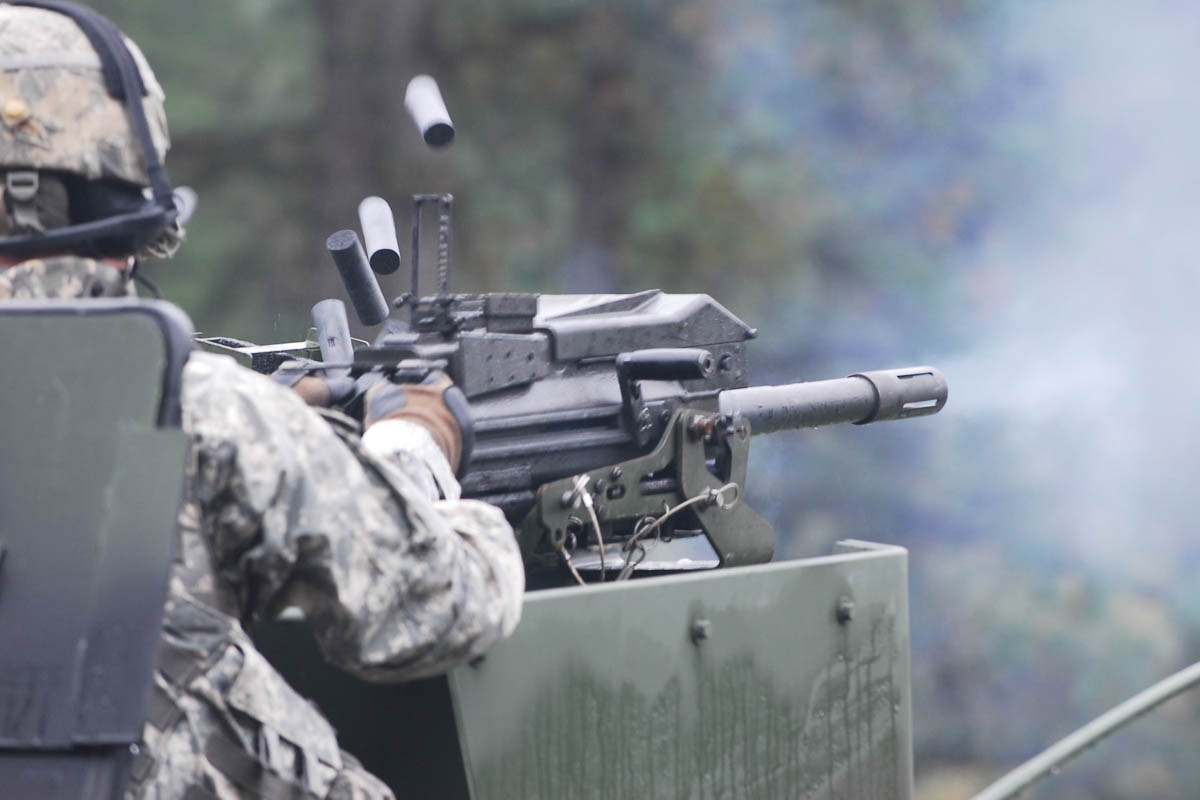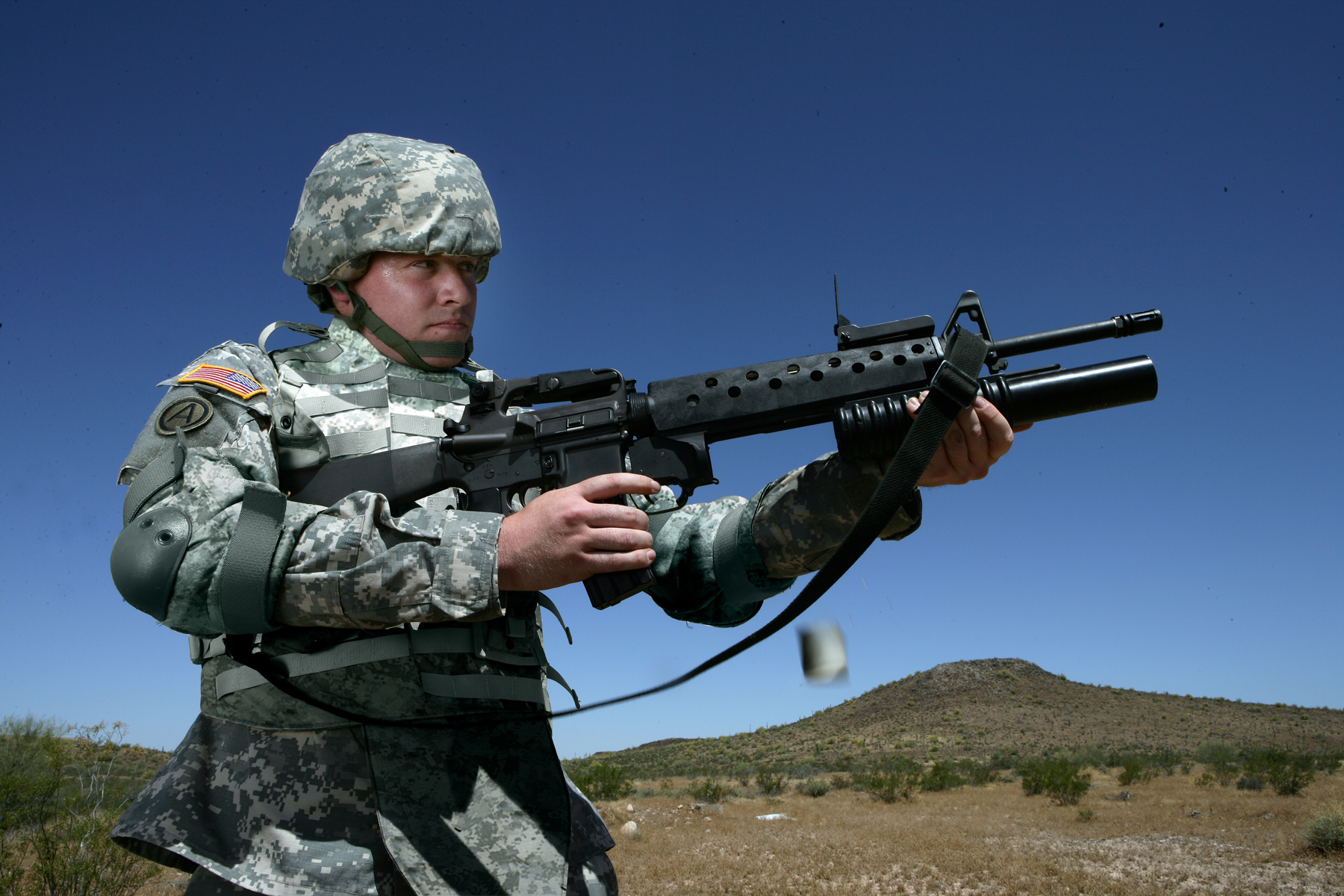Marine Grenade Launcher - M32A1: US Marines can do more damage with their revolver - You know how a revolver works when it comes to shooting guns. How about the same idea to make a rotating explosive speaker?
That's what the U.S. The Marine Corps is proud of its M32A1 Multi-shot Grenade Launcher. This thing brings heat fast. Marines can rapidly fire six 40mm shells in less than three seconds.
Marine Grenade Launcher

The M32A1 is a thing of beauty and has enough power to destroy targets or keep enemies on the ground while suppressing their fire. The M32A1 is like a hand-held mortar that is more accurate than when Marines throw the grenade themselves. Also, it could one day produce drones from its tubes.
U.s. Marine Corps Cpl. Mykel Luera Loads A 40mm Grenade Into His M203 Grenade Launcher Before
South Africans helped develop the multishot grenade launcher in the 1980s. The Marines began testing the M32A1 in 2005 and ordered 9,000 units in 2006. This grenade launcher is popular. Many countries use them. It's like having a gun that can detonate explosives quickly and accurately.
The M32A1 can be loaded with low or medium velocity grenades. Sailors can select the type of explosive for launch without changing the charge. If they try to compress the area, the speaker can cover about 444 square yards. The maximum range of the score is 437 meters with low speed shots and 875 meters with medium speed.
The tool is treated with a Teflon nickel coating that keeps dust, marks and corrosion to a minimum. It has a standard Picatinny rail system that allows the inclusion of a variety of different accessories from sights to laser targeting modules.
The grenade launcher is 26 inches long and weighs 18.4 kilograms when loaded. This weight means that the submarine is less likely to carry the M4 carbine, as opposed to the M203 rifle mounted under the gun.
A Marine Checks The Ammunition Belt Of A Mark 19 40 Mm Grenade Launcher During A Combined Arms Demonstration
The most important thing is the speed of fire and the speed of the weapon. It's in a sweet spot - between a dropped grenade and a mortar round. It has served the Navy well in urban warfare in Iraq and urban warfare in Afghanistan. The M32A1 can engage an enemy hiding behind walls or in bunkers. The wave can also shoot fighters in open areas. So, you can see how important it is in the Navy.
Since the M32A1 has proven itself on the battlefield as a grenade launcher, what about expanding its capabilities with new use cases?
One idea would be to fire the mini-drones in rapid succession. No word yet on whether the Marines will test the M32A1 as a drone launcher, but the idea is interesting.

Intended to be taken down with a grenade launcher, the Drone40 is a lot of power. Sailors control it with a smartphone or tablet. It is a mini-quad copter that is 12 kilometers long and flies for up to an hour. It can be returned and reused after initialization.
Motor Transport Marine Adds Machine Gun Skills To Toolbox
There is a small camera on board for gathering intelligence during reconnaissance and reconnaissance. It can send smoke to hide the movement of ships. Sailors can attach small explosives to it. Drone40 can also be equipped with a laser generator to destroy targets or even enemy communications with the power of electronic warfare.
The M32A1 has many advantages. It burns quickly and accurately. It is popular with many soldiers who use it in the field. The M32A1 is easily man-portable and functions as a small mortar for point and area targets. The weapons can also launch a fleet of mini-drones to make Marines even more dangerous with critical situational awareness.
. He is an Emerging Threats expert and former US official. Army infantry. You can follow him on Twitter
Currently serving as the New Editor of Defense and Civil Defense 1945, Brent M. Eastwood, PhD, is the author of Humans, Machines, and Data: Future Trends in Warfare. He is an Emerging Threats expert and former US official. Army Infantry. This article uses empty, non-informative and vulnerable link rot URLs. Please consider converting them to full text to ensure that the text remains verified and to maintain the citation process. Various templates and tools are available to help with formatting, such as Reflinks (documentation), ReFill (documentation) and Citation bot (documentation). (August 2022) (Learn how and how to remove this template message)
Mk 19, Grenade Range Builds Marines' Combat Readiness, Confidence
M320 Grade Launcher Module (GLM) is the name of the US Army. for the new 40 mm system that will replace the M203.
For the US Army, while other services initially still used the older M203. The M320 uses the same High-Low Propulsion System as the M203.
In 2004, the military announced a requirement for a commercial 40 mm loudspeaker. It had to be reliable, ergonomic, more accurate and safer than the M203. It had to be able to fire all 40 mm rounds at low velocity, but was installed from the bridge to accommodate the long-range projectile of the future. The Heckler & Koch proposal was approved in May 2005.

After the US Army After Picatinny Arsal conducted a competitive bidding process for a new 40 mm system, Heckler & Koch was awarded the contract to supply the XM320 in early 2006. The M320 has since been developed, but is not identical to Heckler & Koch. AG36 (the main distinguishing feature is the addition of a folding guide on the front of the rifle for use when the weapon is in a stand-alone position, a feature the AG36 lacks).
Poster, Many Sizes; Marine Shoots A M32 Grenade Launcher
Work on the M320 was scheduled to begin in February 2009, with 71,600 of the GLMs scheduled to complete the M203 by 2015.
The weapon was officially introduced at Fort Bragg in July 2009 by the 1st Brigade Combat Team, 82nd Airborne Division.
In June 2017, Bravo Company, 2nd Combat Engineer Battalion became the first U.S. Marine Corps are issued M320.
The M320 consists of three main components: a trigger mechanism with a gun, a Sight / Night Sight (DNS) manufactured by Insight Technology, Inc and a hand held Laser Range Finder (LRF). Some of the benefits are:
Meet The M203 Grenade Launcher: The U.s. Army And Marine Corps Secret Weapon
The M320 is based on the former Heckler & Koch AG-C, but with Army-specific modifications. It includes a folding foregrip and a shorter barrel for a more compact package. The sights had to be reconfigured to shoot correctly with slightly different ballistics from the shorter barrel lgth. The system would be lighter than the M203 (actually a bit heavier) and not require special sorting equipment. Inserting the breech allows the gradier to load the shell while on target.
It weighs 3.57 lb (1.62 kg) in its basic configuration, 3.89 lb (1.76 kg) with the LRF and electronic sight, and 4.8 lb (2.2 kg) with the stock attached.
The sights on the M320 are located outside the sight, to avoid the problems the M203 had with its sight, which was mounted above the sight and could interfere with the gunner's view, so must be connected separately. This meant that two separate jobs had to be done when fitting the sight into the weapon, and since those sights were not essential to the M203, they had to be timed and when the gun was attached to the gun. LRF helps to eliminate range estimation errors common for shots greater than 100 meters, thus increasing the chances of a first hit.

The M320 can fire all NATO classes of explosive, smoke and light. The pants slide to the side, allowing it to fire many new long-distance, mainly non-lethal rounds, such as Federal Laboratories 'clear impact' (brand name) non-lethal sticks of sponge or sponge marks.
Marines Are Testing Drones That Fly From Grenade Launchers
The M320 works in a double action mode, with an ambidextrous safety. If something goes wrong, the M320 operator just has to pull the machine again. The M203 used a single-action mechanism, which cocked the weapon while cocking the barrel. The operator of the M203 must engage the barrel by unlocking it and pushing it forward to cock the weapon and relock the barrel, then pull the trigger again. The problem with this is that when you tap the barrel, the class is designed to extend and the operator has to make sure it doesn't fall.
The M320 is one of two 40 mm Pike Missile launchers (produced by Raytheon) without modification - the other is the FN EGLM (Hanced Grade Launching Module) developed for the FN SCAR. The Marine Corps just dropped a bomb — or rather, a 40-ton mike — when it announced June 9 that the service had finally received the M320 grenade launcher, just eight years after the Army adopted a new weapon. The Corps is scheduled to receive about 7,000 M320s and will first deliver the new rifle to Marines. From there it will go to other war zones, according to the Corps.
"In agreement with the Commandant of the Navy, the Navy will be the first to receive the M320, then expand to combat engineering teams, reconnaissance teams, Light Armored Reconnaissance companies, Special Forces Marine operations and MOS training areas," Barb Hamby, a Marine Corps spokesman, told Task & Purpose in an email.
Currently, Marines with the 2nd Combat Engineer Battalion
Marines Corps News
Grenade launcher nerf gun, fake grenade launcher, lego grenade launcher, grenade launcher sound effect, tank grenade launcher, nerf fortnite grenade launcher, m67 grenade launcher, nerf grenade launcher, foam grenade launcher, grenade launcher holster, m320 grenade launcher holster, replica grenade launcher
0 Comments